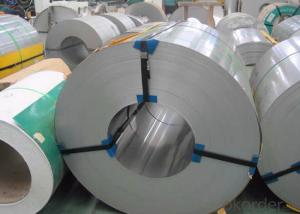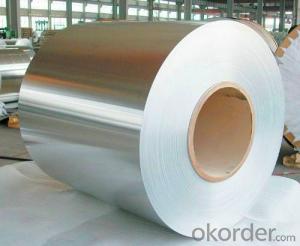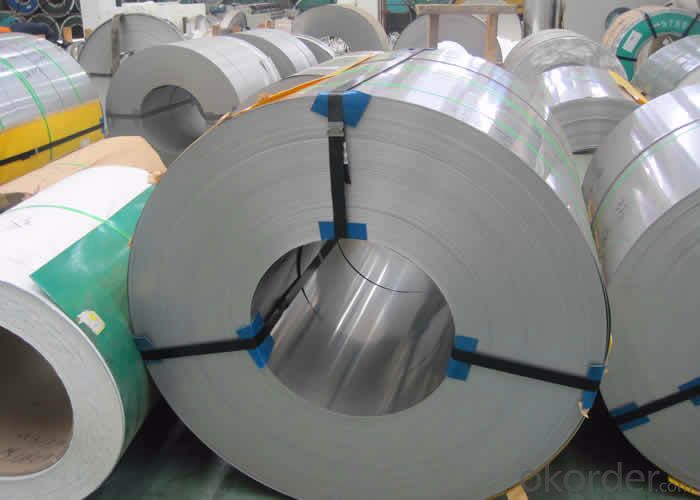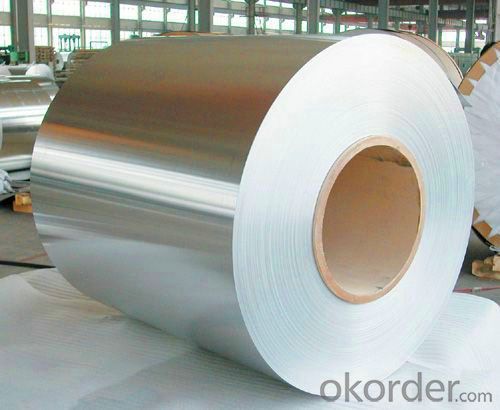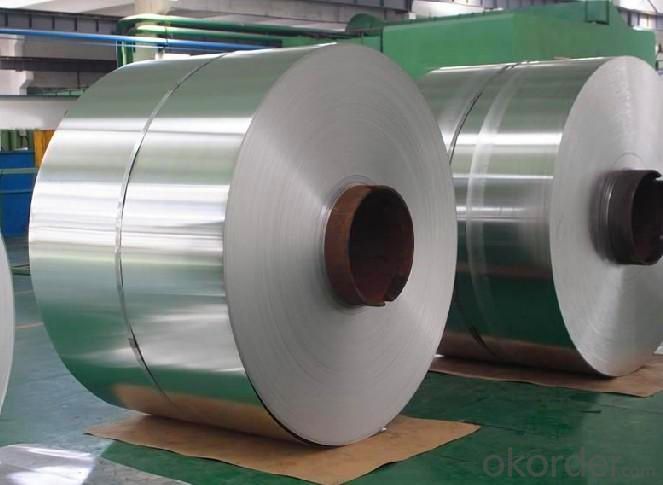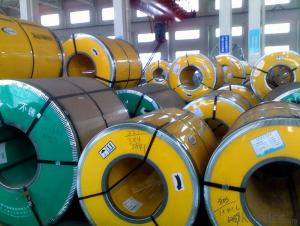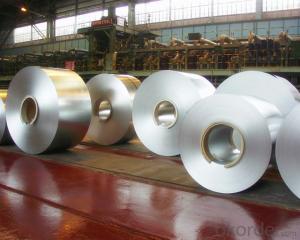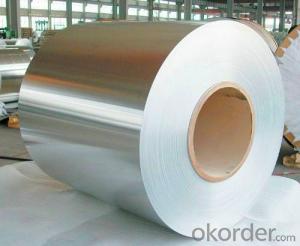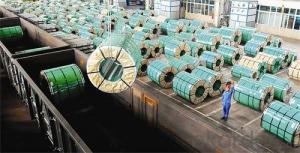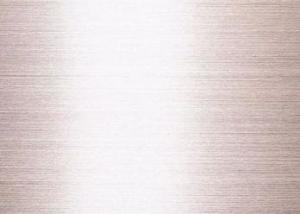Stainless Steel Coil Cold Rolled 304 With Good Quality
- Loading Port:
- Shanghai
- Payment Terms:
- TT OR LC
- Min Order Qty:
- 100 m.t.
- Supply Capability:
- 5000 m.t./month
OKorder Service Pledge
OKorder Financial Service
You Might Also Like
Specification
Stainless Steel Coil Cold Rolled 304 With Good Quality
1.Structure of Stainless Steel Coil Cold Rolled 304 With Good Quality
Cold Rolled stainless steel Coil with good quality is one of the raw material of the cold rolled stainless steel Coil, which can be used directly in many places. Stainless Steel (Stainless Steel) is short for acid-proof Stainless Steel, resistant to weak corrosive medium such as air, steam, water, or with a Stainless Steel grade.
2.Main Features of Prefabricated Steel Structure High Building Project
1) Weldability: The purpose of the different requirement for welding performance are different.1 Kind of tableware generally do not require the performance of welding, even including some pot class enterprise. But the vast majority of products all need raw materials welding performance is good, like the 2 kinds of tableware, thermos flask, steel pipes, water heaters, water dispensers, etc.
2) Corrosion resistance The vast majority of stainless steel products for corrosion resistant performance is good, like a, 2 kinds of tableware, kitchen utensils and appliances, water heaters, water dispensers, etc., some foreign businessmen on corrosion resistance of products also do experiment: in NACL aqueous solution heated to boiling, after a period of time the best solution, wash and drying, weight loss, to determine the degree of corrosion (note: the product polishing, because of the sand cloth or sandpaper containing Fe, will cause the test surface rust spots)
3. Stainless Steel Coil Cold Rolled 304 With Good Quality Images
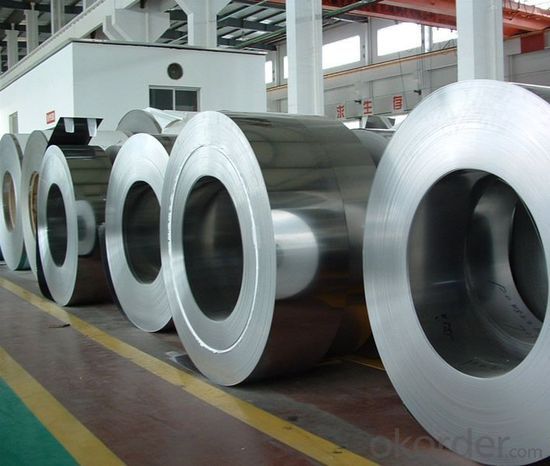
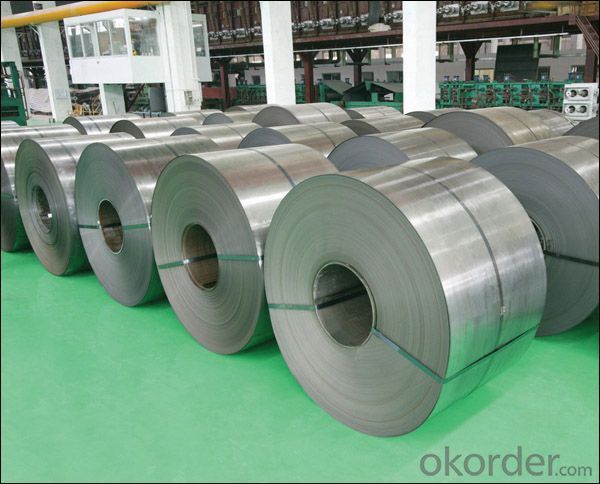
4. Stainless Steel Coil Cold Rolled 304 With Good Quality Specification
The word "stainless steel" is not merely refers to a pure stainless steel, but said more than one hundred kinds of stainless steel industry, the development of each stainless steel has good performance in their specific applications. The key to the success of the first is to make clear purpose, and then determine the correct material. Related to architectural construction applications usually only six types of steel. They contain 17 ~ 22% chromium, good steel contains nickel. Add molybdenum can further improve the atmospheric corrosion resistance, especially containing chloride atmospheric corrosion resistance. Stainless steel often according to the state of organization can be divided into: martensite steel, ferritic steel, austenitic steel, austenitic (two-phase) - ferrite stainless steel and precipitation hardening stainless steel, etc. In addition, according to ingredients can be divided into: chromium stainless steel, chromium nickel stainless steel and chromium manganese nitrogen stainless steel, etc.
5. Applications of Stainless Steel Coil 304 With Good Quality
1. Kitchenware: tableware, cookware, Stoves…
2. Food packing: storage cans, food containers…
3. Construction: bridge, roofing, wall, decoration, bathroom accessories…
4. Precision instruments: electrical products, aerospace…
5. Others: automotive parts, machine building, chemical processing, farming…
6.FAQ of Stainless Steel Coil 304 With Good Quality
We have organized several common questions for our clients,may help you sincerely:
①How about your company?
A world class manufacturer & supplier of castings forging in carbon steel and alloy steel,is one of the large-scale professional investment casting production bases in China,consisting of both casting foundry forging and machining factory. Annually more than 8000 tons Precision casting and forging parts are exported to markets in Europe,America and Japan. OEM casting and forging service available according to customer’s requirements.
②How to guarantee the quality of the products?
We have established the international advanced quality management system,every link from raw material to final product we have strict quality test;We resolutely put an end to unqualified products flowing into the market. At the same time, we will provide necessary follow-up service assurance.
③How is the packaging and delivery?
Standard export packing (Coil: waterproof paper + protective steel ring; Circle: wooden box), or as your requirement and the delivery term is based on the project.
④How long can we receive the product after purchase?
In the purchase of product within 20 working days, We will arrange the factory delivery as soon as possible. The specific time of receiving is related to the state and position of customers. Commonly 20 to 40 working days can be served.
③How is the packaging and delivery?
Standard export packing (Coil: waterproof paper + protective steel ring; Circle: wooden box), or as your requirement and the delivery term is based on the project.
④How long can we receive the product after purchase?
In the purchase of product within 20 working days, We will arrange the factory delivery as soon as possible. The specific time of receiving is related to the state and position of customers. Commonly 20 to 40 working days can be served.
- Q: Can stainless steel strips be used in the wastewater treatment industry?
- Yes, stainless steel strips can be used in the wastewater treatment industry. Stainless steel is a material known for its corrosion resistance, durability, and strength, making it ideal for various applications in wastewater treatment plants. Stainless steel strips can be used in the construction of tanks, pipelines, and other equipment that come into contact with wastewater. In wastewater treatment plants, stainless steel strips are commonly used in the fabrication of screens, filters, and sieves. These components are crucial for removing solid particles, debris, and other impurities from the wastewater. Stainless steel strips are resistant to corrosion caused by the harsh chemicals and contaminants present in the wastewater, ensuring the longevity and effective performance of these components. Additionally, stainless steel strips are also used in the construction of pumps, valves, and fittings in wastewater treatment plants. These components need to withstand high pressure, aggressive chemicals, and continuous exposure to wastewater. Stainless steel's excellent mechanical properties, including high tensile strength and resistance to erosion, make it a suitable choice for such applications. Furthermore, stainless steel is also hygienic and easy to clean, which is essential in the wastewater treatment industry to prevent the growth and accumulation of bacteria and other harmful microorganisms. Stainless steel strips can be easily maintained, reducing the risk of contamination and ensuring the efficiency of the treatment process. Overall, stainless steel strips are a reliable and durable material for use in the wastewater treatment industry. They offer excellent corrosion resistance, strength, and hygienic properties, making them suitable for various applications in wastewater treatment plants.
- Q: How do stainless steel strips perform in corrosive marine environments?
- Stainless steel strips are highly resistant to corrosion and perform exceptionally well in corrosive marine environments. Due to their unique composition of chromium, nickel, and other alloying elements, stainless steel strips form a protective oxide layer on their surface, which acts as a barrier against corrosive elements such as saltwater, moisture, and atmospheric conditions present in marine environments. This corrosion-resistant property of stainless steel strips makes them ideal for various marine applications such as boat fittings, marine hardware, offshore platforms, and underwater structures. They can withstand the harsh conditions of saltwater, waves, and high humidity, without losing their structural integrity or aesthetic appeal. Furthermore, stainless steel strips offer excellent resistance to pitting and crevice corrosion, which are common types of corrosion encountered in marine environments. This ensures their long-term durability and reliability, even in highly corrosive conditions. Additionally, stainless steel strips are easy to clean and maintain, as they do not require any additional coatings or treatments to protect against corrosion. Regular cleaning with fresh water is typically sufficient to keep them in excellent condition. Overall, stainless steel strips are an excellent choice for corrosive marine environments due to their outstanding corrosion resistance, strength, and longevity. They provide a cost-effective and reliable solution that can withstand the challenges posed by the marine environment, ensuring a long-lasting performance.
- Q: Are stainless steel strips suitable for heat exchanger tubes?
- Indeed, stainless steel strips prove to be appropriate for heat exchanger tubes. Renowned for its remarkable resistance against corrosion and heat, stainless steel emerges as an exemplary substance for heat exchanger purposes. Boasting elevated strength, endurance, and the ability to withstand high temperatures, stainless steel strips possess the necessary qualifications for employment within heat exchanger tubes. Furthermore, stainless steel's ease of cleaning and maintenance guarantees the sustained functionality and dependability of the heat exchanger over time.
- Q: What are the factors affecting the formability of 111 stainless steel strips?
- 111 stainless steel strips can be affected by various factors: 1. The formability of the stainless steel strip is greatly influenced by its alloy composition. The presence of elements like chromium, nickel, and molybdenum in different proportions can have a significant impact. Increased amounts of certain elements can enhance the strip's ability to be shaped according to desired specifications. 2. The size of the grains within the stainless steel strip also affects its formability. Smaller grain sizes generally result in improved formability due to a more uniform and consistent material structure. 3. Mechanical properties, such as strength, ductility, and hardness, play a crucial role in determining the formability of the stainless steel strip. Strips with higher ductility are generally easier to shape without experiencing cracks or breakages. 4. The surface condition of the stainless steel strip, including roughness and cleanliness, has an impact on its formability. A smooth and clean surface reduces friction and facilitates shaping without defects. 5. The temperature at which the stainless steel strip is formed can also influence its formability. Higher temperatures soften the material, making it more malleable and easier to shape. 6. Lubrication during the forming process is crucial for improving formability. The use of lubricants reduces friction, preventing galling, scratching, or sticking during forming operations. 7. The method used to form the stainless steel strip, such as bending, stretching, or deep drawing, affects its formability. Different forming methods exert varying levels of stress and strain on the material, impacting its ability to be shaped without failure. In conclusion, a range of factors, including alloy composition, grain size, mechanical properties, surface condition, temperature, lubrication, and forming method, all contribute significantly to the formability of 111 stainless steel strips.
- Q: Are 111 stainless steel strips suitable for architectural applications?
- Yes, 111 stainless steel strips are suitable for architectural applications.
- Q: Can stainless steel strips be magnetized?
- Yes, stainless steel strips can be magnetized. While stainless steel is generally considered non-magnetic, certain types of stainless steel can exhibit magnetic properties when subjected to specific conditions. The magnetic properties of stainless steel are influenced by its chemical composition, heat treatment, and manufacturing process. Austenitic stainless steel, which is the most common type, is generally non-magnetic. However, it can become slightly magnetic when cold worked or deformed, such as in the case of stainless steel strips. On the other hand, ferritic and martensitic stainless steels are magnetic in their annealed or hardened state. These types of stainless steel strips can be easily magnetized and retain magnetism even after the external magnetic field is removed. Therefore, it is important to consider the specific type of stainless steel strip before determining its magnetic properties.
- Q: Can stainless steel strips be welded?
- Indeed, welding is a viable option for stainless steel strips. Stainless steel, being a versatile material, offers the possibility of being welded through the utilization of diverse welding techniques such as TIG welding (Tungsten Inert Gas), MIG welding (Metal Inert Gas), and resistance welding. Nevertheless, it is worth noting that not all stainless steel strips lend themselves easily to welding. Some stainless steel grades possess higher carbon content, rendering them susceptible to sensitization and thereby leading to weld decay or corrosion. Consequently, it is of utmost importance to carefully select the appropriate grade of stainless steel strip and employ the correct welding process in order to guarantee a robust and enduring weld joint.
- Q: Can stainless steel strips be used in the production of jewelry clasps?
- Yes, stainless steel strips can be used in the production of jewelry clasps. Stainless steel is a durable and corrosion-resistant material, making it suitable for various applications in the jewelry industry. It provides strength and stability to clasps, ensuring the longevity of the jewelry piece. Additionally, stainless steel's versatility allows for various designs and finishes, making it a popular choice for clasps in different jewelry styles.
- Q: Can stainless steel strips be used in the production of aerospace components?
- Yes, stainless steel strips can be used in the production of aerospace components. Stainless steel offers excellent strength, corrosion resistance, and heat resistance properties, making it suitable for various aerospace applications. It is commonly used in the fabrication of aircraft structures, engine components, and other vital aerospace parts.
- Q: How do stainless steel strips perform in high temperature environments?
- Stainless steel strips perform exceptionally well in high temperature environments due to their excellent heat resistance properties. They maintain their strength and structural integrity, without deformation or warping, even under extreme heat conditions. This makes stainless steel strips a reliable choice for various applications in industries like aerospace, power generation, and automotive, where high temperatures are prevalent.
Send your message to us
Stainless Steel Coil Cold Rolled 304 With Good Quality
- Loading Port:
- Shanghai
- Payment Terms:
- TT OR LC
- Min Order Qty:
- 100 m.t.
- Supply Capability:
- 5000 m.t./month
OKorder Service Pledge
OKorder Financial Service
Similar products
Hot products
Hot Searches
Related keywords
